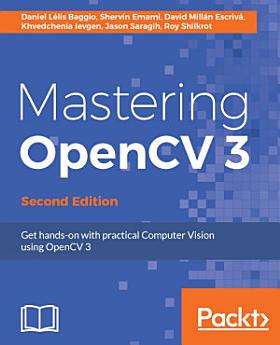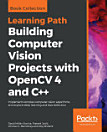Mastering OpenCV 3: Edition 2
Um þessa rafbók
This book is for those who have a basic knowledge of OpenCV and are competent C++ programmers. You need to have an understanding of some of the more theoretical/mathematical concepts, as we move quite quickly throughout the book.
What You Will LearnExecute basic image processing operations and cartoonify an imageBuild an OpenCV project natively with Raspberry Pi and cross-compile it for Raspberry Pi.textExtend the natural feature tracking algorithm to support the tracking of multiple image targets on a videoUse OpenCV 3's new 3D visualization framework to illustrate the 3D scene geometryCreate an application for Automatic Number Plate Recognition (ANPR) using a support vector machine and Artificial Neural NetworksTrain and predict pattern-recognition algorithms to decide whether an image is a number plateUse POSIT for the six degrees of freedom head poseTrain a face recognition database using deep learning and recognize faces from that databaseIn DetailAs we become more capable of handling data in every kind, we are becoming more reliant on visual input and what we can do with those self-driving cars, face recognition, and even augmented reality applications and games. This is all powered by Computer Vision.
This book will put you straight to work in creating powerful and unique computer vision applications. Each chapter is structured around a central project and deep dives into an important aspect of OpenCV such as facial recognition, image target tracking, making augmented reality applications, the 3D visualization framework, and machine learning. You'll learn how to make AI that can remember and use neural networks to help your applications learn.
By the end of the book, you will have created various working prototypes with the projects in the book and will be well versed with the new features of OpenCV3.
Style and approachThis book takes a project-based approach and helps you learn about the new features by putting them to work by implementing them in your own projects.
Einkunnir og umsagnir
Um höfundinn
Daniel Lelis Baggio started his work in computer vision through medical image processing at InCor (Instituto do Coracao – Heart Institute) in Sao Paulo, where he worked with intravascular ultrasound image segmentation. Since then, he has focused on GPGPU and ported the segmentation algorithm to work with NVIDIA's CUDA. He has also dived into 6degrees of freedom head tracking with a natural user interface group through a project called ehci (http://code.google.com/p/ehci/).He now works for the Brazilian Air Force.
David Millan Escriva was 8 years old when he wrote his first program on an 8086 PC with basic language, which enabled the 2D plotting of basic equations. In 2005, he finished his studies in IT through the Universitat Politecnica de Valencia with honors in humancomputer interaction supported by computer vision with OpenCV (v0.96). He had a final project based on this subject and published it on HCI Spanish congress. He participated in Blender, an open source, 3D-software project, and worked on his first commercial movie Plumiferos—Aventuras voladorasas, as a computer graphics software developer. David now has more than 10 years of experience in IT, with experience in computer vision, computer graphics, and pattern recognition, working on different projects and start-ups, applying his knowledge of computer vision, optical character recognition, and augmented reality. He is the author of the DamilesBlog (http://blog.damiles.com), where he publishes research articles and tutorials about OpenCV, Computer Vision in general, and Optical Character Recognition algorithms. David has reviewed the book gnuPlot Cookbook, Packt Publishing, written by Lee Phillips.
Khvedchenia Ievgen is a Computer Vision expert from Ukraine. He started his career with research and development of a camera-based driver assistance system for Harman International. He then began working as a computer vision consultant for ESG. Nowadays, he is a self-employed developer focusing on the development of augmented reality applications. Ievgen is the author of the Computer Vision Talks blog (http://computer-vision-talks.com),where he publishes research articles and tutorials pertaining to computer vision and augmented reality.
Jason Saragih received his BE in mechatronics (with honors) and PhD in computer science from the Australian National University, Canberra, Australia, in 2004 and 2008, respectively. From 2008 to 2010, he was a Postdoctoral fellow at the Robotics Institute of Carnegie Mellon University, Pittsburgh, PA. From 2010 to 2012, he worked at the Commonwealth Scientific and Industrial Research Organization (CSIRO) as a research scientist. He is currently a senior research scientist at Visual Features, an Australian tech start-up company. Dr. Saragih has made a number of contributions to the field of computer vision, specifically on the topic of deformable model registration and modeling. He is the author of two nonprofit open source libraries that are widely used in the scientific community; DeMoLib and FaceTracker, both of which make use of generic computer vision libraries, including OpenCV.
Roy Shilkrot is a researcher and professional in the area of computer vision and computer graphics. He obtained a BSc in computer science from Tel-Aviv-Yaffo Academic College, and an MSc from Tel-Aviv University. He is currently a PhD candidate in Media Laboratory of the Massachusetts Institute of Technology (MIT) in Cambridge. Roy has over seven years of experience as a software engineer in start-up companies and enterprises. Before joining the MIT Media Lab as a research assistant, he worked as a technology strategist in the Innovation Laboratory of Comverse, a telecom solutions provider. He also dabbled in consultancy, and worked as an intern for Microsoft research at Redmond.




